- Home
- »
- Consumer F&B
- »
-
Beef Market Size, Share And Growth Analysis Report, 2030GVR Report cover
![Beef Market Size, Share & Trends Report]()
Beef Market Size, Share & Trends Analysis Report By Cut (Brisket, Shank, Loin), By Slaughter Method (Kosher, Halal), By Region, And Segment Forecasts, 2024 - 2030
- Report ID: 978-1-68038-175-7
- Number of Pages: 80
- Format: Electronic (PDF)
- Historical Range: 2018 - 2022
- Industry: Consumer Goods
Beef Market Size & Trends
The global beef market size was valued at USD 526.50 billion in 2023 and is expected to grow at a compound annual growth rate (CAGR) of 4.2% from 2024 to 2030. With increasing globalization, food preferences of consumers globally have witnessed significant changes. Consumers are increasing their protein intake, resulting in a rising demand for meat. Meat and its products are packed with a host of essential ingredients and nutrients and save a lot of time and effort in cooking. Therefore, manufacturers are primarily focusing on the quality of meat and its products.
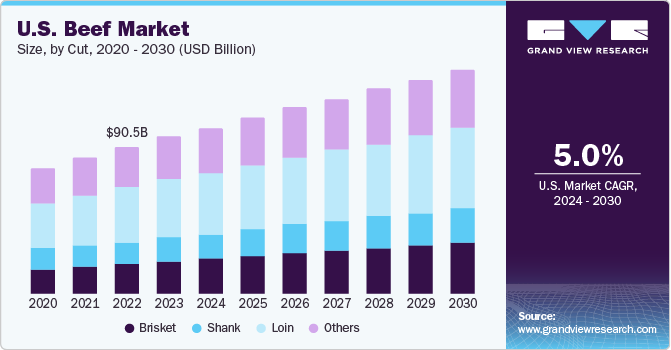
Rising health consciousness among the masses, along with an increasing demand for animal-sourced protein, is a key factor driving the beef industry. With changing dietary habits, consumer preferences are rapidly shifting toward food products with low fat and calorie content and high protein value. Additionally, the increasing utilization of beef in the food industry is favoring market growth. Beef-based burgers, hotdogs, sausages, fillets & steaks, and stews are widely served across cafes and restaurants to offer consumers authentic and multi-cuisine dishes.
Some key factors propelling meat demand are the steadily rising income of middle-class consumers in the developing countries of Latin America and Asia Pacific regions, as well as significant demand for convenience foods among the working population and younger generations keen on cooking at home. Over the past few years, busy daily schedules of consumers have widened the market scope for ready-to-eat meat products globally.
Market Concentration & Characteristics
The degree of innovation in the market for beef is quite significant and encompasses a range of areas from sustainable practices to technological advancements. One major trend is the shift towards alternative proteins, such as plant-based & insect proteins, and cultured meat. These innovations are a response to the environmental impact of traditional meat production and consumer health concerns. Companies are developing products such as 'bloody' meatless burgers and cell-based steaks that closely resemble traditional meat in taste and texture. Start-ups like Impossible Foods and Beyond Meat have made significant strides in this area, launching improved versions of their plant-based burgers that are more appealing to a broader market, including meat eaters
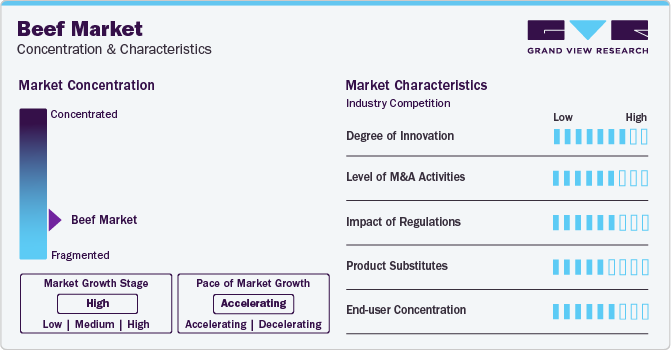
Several market players such asTyson Foods, Inc., Danish Crown, and Hormel Foods Corporation, are involved in merger and acquisition activities. Through this strategy, these companies can expand their geographic reach and enter new territories.
The degree of innovation in the beef industry encompasses a broad spectrum of advancements and novel approaches aimed at addressing contemporary challenges and opportunities in the industry. This includes the adoption of sustainable farming practices, which focus on reducing environmental impacts through improved grazing management and feed efficiency. Additionally, there's a growing interest in alternative protein sources, such as lab-grown meat and plant-based substitutes, catering to environmental concerns and diverse dietary preferences. Genetic engineering is also pivotal, with efforts directed towards enhancing disease resistance, growth rates, and meat quality in cattle.
Product substitutes for beef are increasingly diverse, catering to various dietary preferences, health concerns, and environmental considerations. One of the most popular alternatives is plant-based meat, made from ingredients like soy, peas, or wheat gluten, which replicate the taste and texture of beef. These are particularly favored by vegetarians, vegans, and those looking to reduce meat consumption for health or environmental reasons. Another innovative substitute is lab-grown meat, also known as cultured meat, which offers a solution that addresses both environmental impact and animal welfare concerns.
Cut Insights
Loin cut held a leading revenue share of 36.3% in 2023 in the global beef industry. A rising health consciousness among masses, along with an increasing demand for animal-sourced proteins, are key factors driving expansion in the beef market. Loin cut benefits greatly from dry aging. Also, these are the most tender, flavorful, and juiciest section, which helps drive their demand.
Meanwhile, the brisket segment is projected to expand at the fastest CAGR through 2030. Brisket is the meat surrounding the breastbone; it is the lower breast or pectoral muscle of the animal and is one of the primal cuts. Since this area is so well-exercised, it makes for a rather tough piece of meat that is full of connective tissues and, therefore, is best suited for a low and slow cooking process. It is a coarse-grained and thick meat, which requires a lot of time and low temperature to tenderize and break down. Brisket is one of the most flavorful cuts of meat. These cuts are popular due to their low cost and are mostly used in BBQs.
Slaughter Method Insights
Halal beef held a substantial revenue share in 2023 in the global market. The growing Islamic population worldwide mostly drives demand for halal products. Halal beef is free from any component that Muslims are prohibited from consuming, and is processed or produced in accordance with Islamic laws. It is commonly known as the Islamic slaughter method, wherein the cut must sever at least three of the trachea, esophagus, and the two blood vessels on either side of the throat. Halal beef is one of the most preferred forms of meat for followers of Islam, since the religion prohibits consumption of pork.
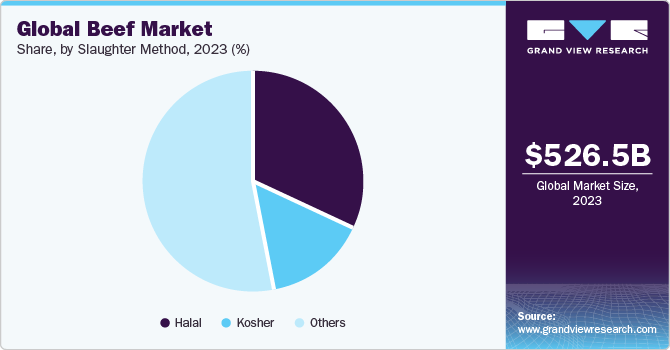
Meanwhile, kosher beef industry is projected to advance at a steady CAGR from 2024 to 2030. Kosher is a form of beef primarily consumed by the global Jewish population. It is consumed in accordance with Jewish dietary laws, which dictate what Jewish people can and cannot eat based on their religion and how food items should be prepared. The word kosher is an umbrella term for foods that fit into these dietary laws according to Jewish traditions. Cattle that have died of natural causes, those that other animals kill, or those that have diseases or flaws cannot be used for kosher beef.
Regional Insights
Asia Pacific accounted for 48.0% of the global beef industry revenue share in 2023. Key markets for beef in this region are China, India, Pakistan, Japan, and Australia. China is one of the world’s largest markets for beef as the country is witnessing a significant rise in its consumption, driven by increasing disposable incomes. Ongoing shortages and pandemic-related labor shortages, specifically in a country like China, are likely to support the import of frozen beef, with Australia being the biggest supplier.
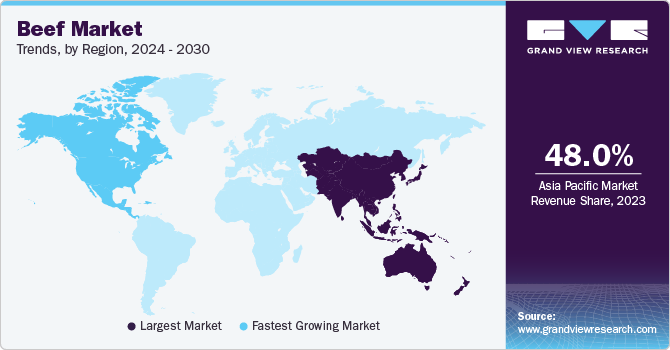
The North American market is expected to register a significant CAGR through 2030, owing to the presence of effective and sound infrastructure such as sophisticated processing facilities and transportation networks, as well as intellectual expertise on issues like genetics, meat quality, and legal property rights. North America is the world’s largest producer of beef for domestic and export markets. Despite the fact that grasslands are North America’s most threatened terrestrial ecosystem, largely due to climatic and market pressures, most beef cattle are grass-fed at some point during their lifecycle.
Key Beef Company Insights
Tyson Foods, Inc.; JBS; Cargill Incorporated; and National Beef Packing Company are some of the dominant players operating in the market for beef.
-
In February 2022, JBS presented at Gulfood 2022, the world's largest annual food and beverage trade show, held in Dubai (UAE). Friboi, the top-selling Brazilian beef brand under JBS, offered attendees an experience with the Black Friboi and 1953 ranges. Black Friboi consists of the brand's most premium halal portfolio derived from the top genetic Black Angus in the United States; only 1% of the cattle meet the selection criteria
-
In July 2021, Israel-based cultured meat company Aleph Farms received USD 105 million in a Series B investment round, bringing its funding up to USD 119.4 million, according to Crunchbase. The company planned to use this money to prepare for a 2022 product launch by scaling up manufacturing facilities, growing international operations, and expanding its product lines and tech platform
Key Beef Companies:
The following are the leading companies in beef market. These companies collectively hold the largest market share and dictate industry trends. Financials, strategy maps & products of these beef companies are analyzed to map the supply network.
- Tyson Foods, Inc.
- Danish Crown
- Cargill Incorporated
- Marfrig Global Foods S.A.
- NH Foods Ltd.
- Minerva Foods
- St. Helen’s Meat Packers
- Hormel Foods Corporation
- JBS USA
- National Beef Packing Company, LLC
- Vion Food Group
- Australian Agricultural Company Limited
Beef Market Report Scope
Report Attribute
Details
Market size value in 2024
USD 555.25 billion
Revenue forecast in 2030
USD 712.54 billion
Growth Rate
CAGR of 4.2% from 2024 to 2030
Base year for estimation
2023
Historical data
2018 - 2022
Forecast period
2024 - 2030
Report updated
February 2024
Quantitative units
Revenue in USD million/billion and CAGR from 2024 to 2030
Report coverage
Revenue forecast, company ranking, competitive landscape, growth factors, and trends
Segments covered
Cut, slaughter method, region
Regional scope
North America; Europe; Asia Pacific; Central & South America; Middle East & Africa
Country scope
U.S.; Canada; Mexico; Germany; Russia; Switzerland; China; India; Japan; Australia; South Korea; Brazil; Argentina; Colombia
Key companies profiled
Tyson Foods, Inc.; Danish Crown; Cargill Incorporated; Marfrig Global Foods S.A.; NH Foods Ltd.; Minerva Foods; St. Helen’s Meat Packers; Hormel Foods Corporation; JBS USA; National Beef Packing Company, LLC; Vion Food Group; Australian Agricultural Company Limited
Customization scope
Free report customization (equivalent up to 8 analysts working days) with purchase. Addition or alteration to country, regional & segment scope.
Pricing and purchase options
Avail customized purchase options to meet your exact research needs. Explore purchase options
Global Beef Market Report Segmentation
This report forecasts revenue growth at the global, regional & country levels and provides an analysis of the latest industry trends and opportunities in each of the sub-segments from 2018 to 2030. For this study, Grand View Research has segmented the global beef market report on the basis of cut, slaughter method, and region:
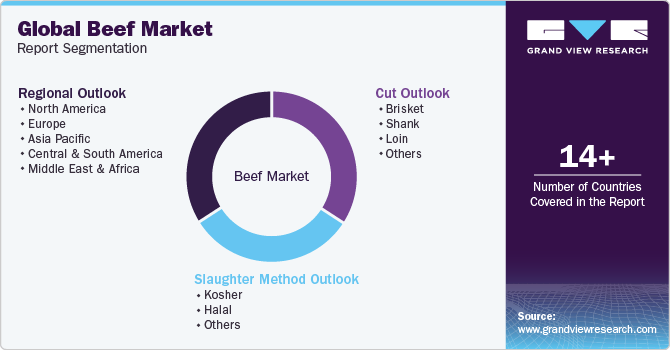
-
Cut Outlook (Revenue, USD Billion, 2018 - 2030)
-
Brisket
-
Shank
-
Loin
-
Others
-
-
Slaughter Method Outlook (Revenue, USD Billion, 2018 - 2030)
-
Kosher
-
Halal
-
Others
-
-
Regional Outlook (Revenue, USD Billion, 2018 - 2030)
-
North America
-
U.S.
-
Canada
-
Mexico
-
-
Europe
-
Germany
-
Russia
-
Switzerland
-
-
Asia Pacific
-
China
-
Japan
-
India
-
Australia
-
South Korea
-
-
Central & South America
-
Brazil
-
Argentina
-
Colombia
-
-
Middle East & Africa
-
Frequently Asked Questions About This Report
b. The global beef market is expected to grow at a compounded growth rate of 4.2% from 2024 to 2030 to reach USD 712.54 billion by 2030.
b. The loin segment was valued at USD 191.31 billion in 2023 and is anticipated to reach USD 254.88 billion by 2030 at a CAGR of 4.0% during the forecast period. The rising health consciousness among the masses, along with the increasing demand for animal-sourced protein, is one of the key factors driving the market. Loin cut benefits greatly from dry aging. Also, these are the tenderest, juiciest, and the most flavorful.
b. "Some key players operating in beef market include Tyson Foods, Inc.; Danish Crown; Cargill Incorporated; Marfrig Global Foods S.A.; NH Foods Ltd.
b. Key factors that are driving the market growth include innovation in meat processing industry and increase in health and nutrition awareness
b. The global beef market size was estimated at USD 526.50 billion in 2023 and is expected to reach USD 555.25 billion in 2024.
Share this report with your colleague or friend.
![gvr icn]()
NEED A CUSTOM REPORT?
We can customize every report - free of charge - including purchasing stand-alone sections or country-level reports, as well as offer affordable discounts for start-ups & universities. Contact us now
![Certified Icon]()
We are GDPR and CCPA compliant! Your transaction & personal information is safe and secure. For more details, please read our privacy policy.
We are committed towards customer satisfaction, and quality service.
"The quality of research they have done for us has been excellent."





